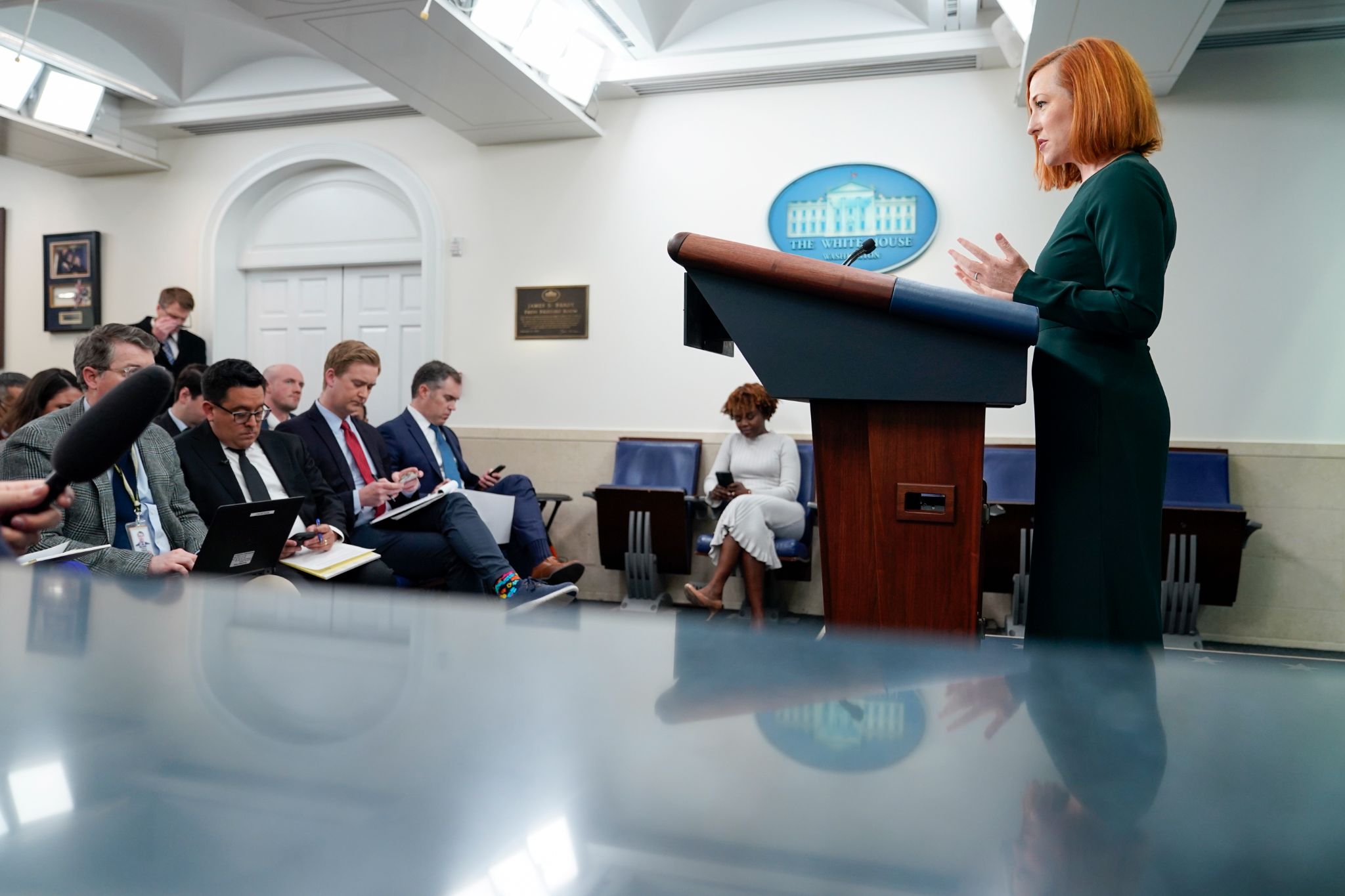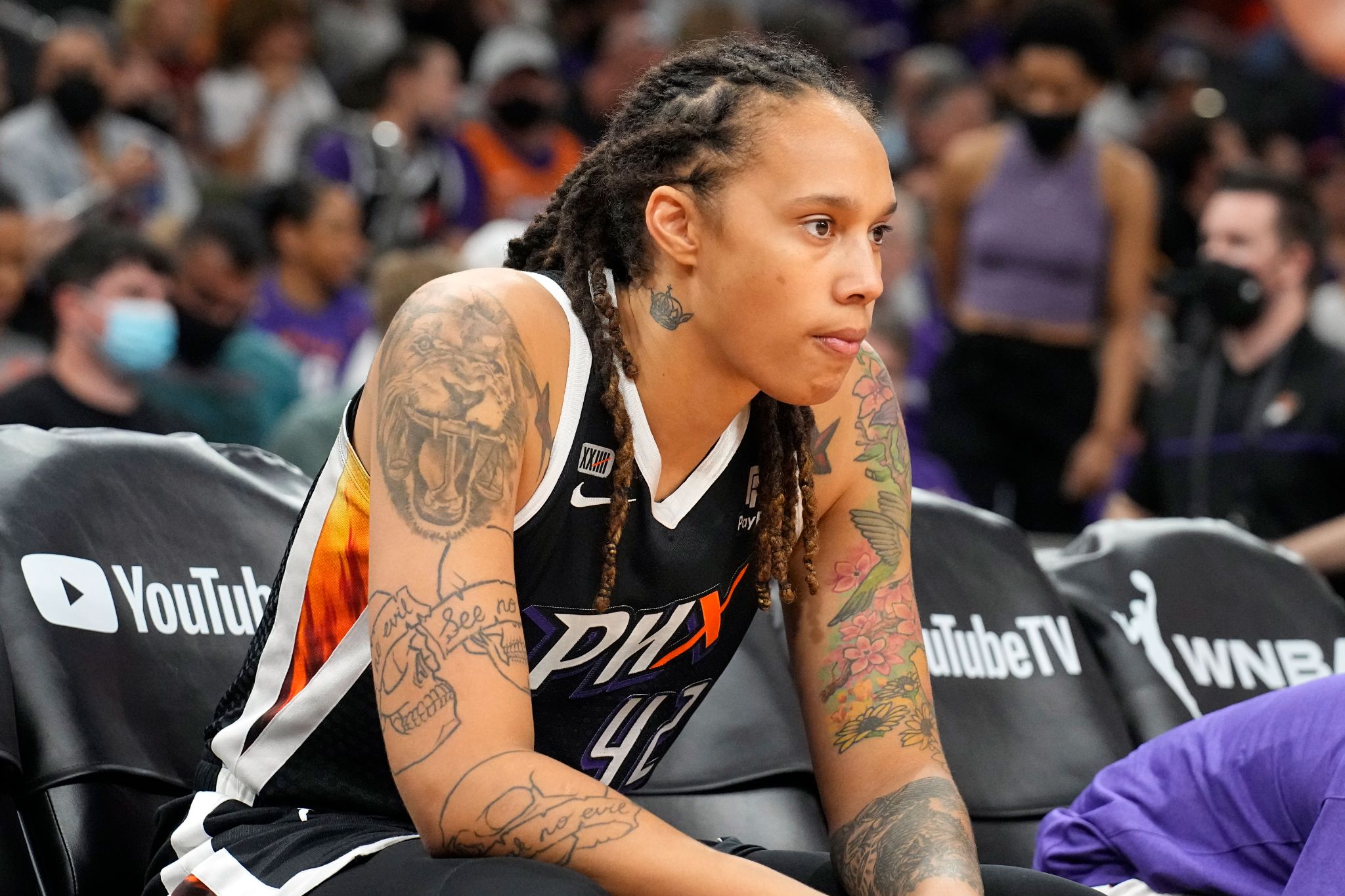Dead bodies lying in the streets. A maternity ward blasted into rubble. Crying children boarding trains while clinging to their fathers who are staying behind to fight.
These are just some of the disturbing images, videos and stories we’ve heard over the past two weeks as Russia continues its relentless attack on Ukraine.
And the coverage has been dogged.
At any hour of the day, one can turn on CNN or go to the website of The New York Times or The Washington Post and see ominous headlines to go along with devastating visuals. For news consumers, it can become overwhelming to the point where, occasionally, we must turn away.
But this uncompromising and tireless coverage of the war remains critical — not only for the world to witness what is happening, but to make sure the world remains committed to not forgetting about or abandoning the people of Ukraine.
Take this story from The Associated Press’ Evgeniy Maloletka: “Airstrike hits Ukraine maternity hospital, 17 reported hurt.” And this one from The Washington Post’s Adela Suliman and David L. Stern: “Chernobyl plant disconnected from power grid; Ukraine demands cease-fire for urgent repairs.” And this one Bloomberg Businessweek’s Marc Champion: “Putin’s Endgame Starts to Look Like Reducing Ukraine to Rubble.” And The Washington Post’s Karoun Demirjian with “Pentagon says Russia appears to be hitting Ukrainian civilians with ‘dumb bombs.’” And The New York Times’ Andrew E. Kramer with “They Died by a Bridge in Ukraine. This Is Their Story.”
Read these stories. These are just drops in a gigantic bucket of important stories being done.
We often hear the term “journalism matters” when a local newspaper catches a mayor or city councilman with his hand in the till or a TV station reports on children in harm’s way because of unsafe conditions at a school. And it’s true in those cases that journalism does matter. Later in the newsletter, there are a half dozen projects up for a prestigious award because of important investigations that impact the lives of real people.
But in the case of Russia and Ukraine, the mantra of “journalism matters” has rarely had higher stakes.
I was tempted to say that there is a fine line between news outlets showing the real impact of the violence that is happening in Ukraine and showing too much that it turns viewers off, or desensitizes them. But there is no line. News outlets — with their brave reporters who are literally risking their lives to tell these important stories — must continue to show all it can for as long as this lasts.
This story is too important to do it any other way.
Notable Russia-Ukraine stories
- The New York Times’ Max Fisher with “Russia’s Other Contest With the West: Economic Endurance.”
- Also in The New York Times, opinion columnist Thomas L. Friedman with “Putin Has No Good Way Out, and That Really Scares Me.”
- Digiday’s Kayleigh Barber with “‘Misinformation on TikTok is a whole different beast’: How publishers are tackling the Ukraine-Russia war disinformation problem on TikTok.”
- A column by USA Today’s Carli Pierson: “Russia blew up a hospital maternity ward. Putin is a war criminal committing genocide.”
- Fox News’ Trey Yingst reports on the devastation from Kyiv: “We are looking at evidence of war crimes taking place before our eyes in Ukraine. … Civilians are dying without dignity and are being buried in mass graves.”
A White House kerfuffle

White House press secretary Jen Psaki speaks during a press briefing at the White House on Wednesday. (AP Photo/Patrick Semansky)
The White House press corps had a dustup earlier this week when reporters became angry at one of their own for closing down the press conference of press secretary Jen Psaki. How it traditionally works is that, when sufficient time has passed, the reporter from The Associated Press will say, “Thanks, Jen,” signaling that Psaki can leave.
On Tuesday, after 39 minutes, the AP’s Josh Boak said, “Thanks, Jen,” even though a reporter was yelling a question. Several reporters, particularly those in the back rows, became angry because they didn’t get their questions answered. Many were upset with Boak for ending the presser after 39 minutes.
According to the New York Post, Al Jazeera’s Kimberly Halkett said, “There are five rows back here and none of us got to ask a question.”
As the scene heated up, Steve Portnoy of CBS News Radio, president of the White House Correspondents’ Association, said, “Clearly, we have felt that we have not had enough. So there might be appropriate — an opportunity for we as a press corps to collectively decide when we’ve had enough, and to send that signal on our behalf to the AP man or woman so that he or she can signal to the secretary that we have had enough. I think it’s appropriate for us collectively as a unit, as a press corps, to reach that accommodation.”
On Wednesday, Psaki addressed the matter with the press corps, starting her press conference by saying, “I heard there was a little kerfuffle in here after the briefing yesterday. What we’re going to do today is we’re going to start with the third and fourth row and fifth and sixth row, get more people’s questions answered.”
Psaki added, “I could go on for hours. But we all know you all have a lot on your plates, so what we try to do for everybody’s knowledge is balance between all the things reporters and all of you have focused on … but we also are here as people have follow-up questions.”
The Hill’s Dominick Mastrangelo wrote, “Tuesday’s spat underscores a frequent gripe made by reporters from smaller outlets seated near the back of the briefing room that journalists from larger news organizations such as national television networks take up an exorbitant amount of time during briefings, often asking several follow-up questions of topics of varying news value.”
The Smiths make a big hire
Politico Playbook broke the news Wednesday morning that Steve Clemons, the current editor-at-large for The Hill, is joining the media startup being headed by former New York Times media columnist Ben Smith and Bloomberg CEO Justin Smith. For now, the startup is being called Project Coda.
Clemons will be the editor-at-large and run the new company’s “global live journalism operations.”
In a statement, Justin Smith, who worked with Clemons at The Atlantic, said, “Steve is a world-class journalist and entrepreneur with a global view, and I’m thrilled to work with him again bringing the crucial issues facing America and the world to life. Understanding Washington and its relationship to the world has never been more important than today. Steve is the leading innovator in live journalism, a major area of focus for our global ambitions.”
Clemons said, “I’m convinced that this new venture will be vital in bringing Washington, and the world, what they need right now: High quality journalism that respects its audience’s intelligence.”
A big story that should be bigger

WNBA Brittney Griner in the WNBA Finals last October. (AP Photo/Rick Scuteri)
I’ve actually seen several stories and tweets over the past few days asking why the Brittney Griner story isn’t a bigger deal. ESPN has covered it. So have The New York Times and The Washington Post and CNN. I would argue it is a pretty big story.
Griner is being detained in Russia after authorities there alleged she had cannabis oil in her luggage at a Moscow airport last month. She is being accused of smuggling a narcotic substance — an offense punishable by up to 10 years in prison.
The headline on a New York Magazine piece by Will Leitch is “Why Isn’t Brittney Griner the Biggest Sports Story in the Country?” Leitch’s story was published on Tuesday. Again, I would argue it’s getting plenty of attention, although I also would acknowledge it’s not getting near the coverage as the latest NFL news involving quarterbacks Aaron Rodgers and Russell Wilson or the Major League Baseball lockout or sports fans getting ready for March Madness.
The Griner story has only become a story in the past few days even though she actually was arrested over a month ago.
Leitch wrote, “One of the greatest athletes in American sports — a gold-medal winner, a superstar, a champion — was arrested in a dangerous and volatile country that has suddenly become a pariah on the world stage. Making equivalences between sports only takes you so far here, but seriously: Imagine if Tom Brady were being held by Russian officials right now.”
Griner’s arrest was before Russia’s invasion of Ukraine, but it’s still unclear how the current U.S.-Russia relationship might harm Griner’s chances of being released.
One of the stories that has come out of all this is why is Griner, one of the best players in the WNBA, even playing in Russia? Well, it’s because the maximum salary in the WNBA is just under $229,000. But in the WNBA offseason, players can go to places in Europe, including Russia, and make five or six or seven times that amount.
Leitch wrote, “The precarity of Griner’s position in Russia may give the WNBA a good reason to stay quiet about her case. But perhaps the league would also prefer not to dwell on how she ended up in this situation in the first place.”
Bozeman Daily Chronicle becomes third Adams paper to organize with the NewsGuild
For this item, I turn it over to my Poynter colleague Angela Fu.
The nine editorial staff at the Bozeman (Montana) Daily Chronicle petitioned the National Labor Relations Board Tuesday for an election to certify their union, the Yellowstone News Guild.
If they are successful, they will be the third newspaper owned by the Adams Publishing Group to organize with the NewsGuild, the largest union representing journalists. Workers at the Skagit Valley (Washington) Herald and the Wyoming Tribune Eagle are already represented by unions.
The filing comes after Daily Chronicle journalists sent Adams Publishing regional president Mark Dobie a letter requesting the company voluntarily recognize their union.
“Building a sustainable career in our newsroom is out of reach for many staffers. Many of us are in tenuous housing situations and despite our professional goals know the housing market combined with low pay could force us out of Bozeman,” the staff wrote. “Our pay and working conditions are simply not good enough. Unionizing will result in better conditions for us and, frankly, a better newspaper.”
The company refused, forcing the staff to seek an NLRB election. Adams Publishing did not respond to a request for comment.
The Daily Chronicle’s union drive follows recent controversies at three other Adams Publishing papers. Last month, all four members of the Klamath Falls (Oregon) Herald and News reporting staff quit. Meanwhile, The Athens (Ohio) News and The Athens Messenger have lost nearly all of their journalists to firings and resignations after an editor was fired for violating the company’s social media policies. She had previously criticized advertisements for collectible coins that had run in the papers.
Not much is known about Adams Publishing, which launched in March 2014 and owns more than 100 papers across 20 states. Members of the Adams family rarely talk to the media. In a 2017 profile of the family, Poynter’s Rick Edmonds reported that their net worth has been estimated to be at least a billion dollars.
In a tweet announcing their election petition, the Daily Chronicle journalists said they are preparing for “swift union busting.” They said Dobie announced Wednesday that Adams would hold meetings explaining its opposition to a union.
Finalists named
The Shorenstein Center on Media, Politics and Public Policy at Harvard Kennedy School has announced the six finalists for the 2022 Goldsmith Prize for Investigative Reporting. They are:
- “Wires and Fires” from the Milwaukee Journal Sentinel’s Raquel Rutledge, John Diedrich and Daphne Chen. The investigation looked at electrical fires and how Black renters are hardest hit with little help from the government to fix the problem.
- “Black Children Were Jailed for a Crime That Doesn’t Exist. Almost Nothing Happened to the Adults in Charge” from Meribah Knight and Ken Armstrong of Nashville Public Radio’s WPLN News and ProPublica.
- “Poison in the Air” from ProPublica, in collaboration with The Texas Tribune and Mountain State Spotlight, and reporters Lylla Younes, Ava Kofman, Al Shaw and Lisa Song, with additional reporting by Maya Miller and photography by Kathleen Flynn.
- “Poisoned” from the Tampa Bay Times’ Corey G. Johnson, Rebecca Woolington and Eli Murray. The multi-part series looked at how hundreds of workers have been exposed to alarming levels of poisons at a battery recycling plant.
- “The real damage” from The Washington Post’s Hannah Dreier and Andrew Ba Tran. The investigation looked at why FEMA is denying disaster aid to Black families that have lived for generations in the Deep South.
- “Unresponsive” from The Wichita Eagle/Kansas.com’s Chance Swaim and Michael Stavola. In this investigation into Sedgwick County EMS — the lone ambulance provider for more than half a million people — reporters at The Wichita Eagle uncovered a public safety crisis that put an entire community at risk.
The winner will be announced at the awards ceremony in Cambridge (and livestreamed online) on April 5.
An anniversary to not celebrate

Utah Jazz player Rudy Gobert in a game this week. (AP Photo/Sue Ogrocki)
There was nothing happy about this anniversary. This tweet shows that it was two years ago Wednesday that NBA player Rudy Gobert, as he was about to leave a press conference in which something called “coronavirus” was starting to become a topic, jokingly stood up and touched all the reporters’ tape recorders and microphones.
Two days later, Gobert tested positive for COVID-19. The NBA then shut down and Gobert became known as the league’s “patient zero.”
Months after that infamous press conference, ESPN’s Lisa Salters asked Gobert what he wanted people to know about that moment.
“That it came from a good intention,” Gobert said. “It was the first day that we found out that the media was not going to be able to interview us, right next to us, and, you know, we obviously didn’t know as much as we know now, and I only did that to try to liven the mood a little bit. It was, of course, if I could go back in time, I wouldn’t do it.”
Two years ago — somehow it’s hard to believe that it was that long ago and, at the same time, it seems like forever.
Media tidbits
- Deadline’s Dominic Patten and Ted Johnson report, “Jeff Zucker Reaches Resolution With WarnerMedia Over Abrupt CNN Exit; Won’t Sue.”
- The National Press Photographers Association has named its “2022 Best of Photojournalism Winners.”
- The Washington Post’s Aaron Blake with “A judge uses Tucker Carlson’s own words against Fox News.”
- Celebrated author, sociologist and university professor Tressie McMillan Cottom is joining The New York Times staff as an opinion columnist. In its announcement, the Times wrote, “As a columnist, Tressie will bring her trademark insight and reflection, translating the form of the argued essay across all forms of media. She will explore, as she does in every forum she appears, ideas about success, merit, intelligence and opportunity.”
- The Tampa Bay Times’ Sue Carlton with “For 100 years now, you simply had to read Tampa’s La Gaceta newspaper.”
Hot type
- The New York Times’ Dave Itzkoff with “Al Pacino on ‘The Godfather’: ‘It’s Taken Me a Lifetime to Accept It and Move On.’”
- For Esquire, Adrienne Westenfeld with “My Own Little Fiefdom”: Why Some Famous Novelists Are All About Substack.”
- The BBC’s Jonathan Amos with “Endurance: Shackleton’s lost ship is found in Antarctic.” And for The New York Times, Henry Fountain with “At the Bottom of an Icy Sea, One of History’s Great Wrecks Is Found.”
Have feedback or a tip? Email Poynter senior media writer Tom Jones at tjones@poynter.org.
More resources for journalists
- Subscribe to Poynter’s new Friday newsletter, Open Tabs with Poynter managing editor Ren LaForme, and get behind-the-scenes stories only available to subscribers.
- Hiring? Post jobs on The Media Job Board — Powered by Poynter, Editor & Publisher and America’s Newspapers.
- Follow the Money: American Rescue Plan (Live online workshop) — Apply by March 15.
- Covering Political Extremism in the Public Square (Seminar) April 4-13.
The Poynter Report is our daily media newsletter. To have it delivered to your inbox Monday-Friday, sign up here.







